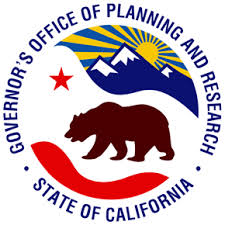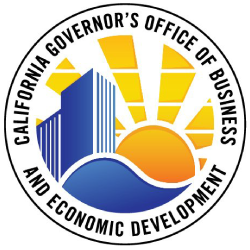
Governor's Office of Planning and Research. (Photo: OPR.ca.gov)
Governor’s Office of Planning and Research
A major focus of OPR is helping mitigate and adapt to global warming
By Chris Micheli, July 17, 2020 8:15 am
An important entity within the Governor’s Office is the Office of Planning and Research (OPR), which plays multiple roles in California state government. It is established in the California Government Code, Chapter 1.5, which sets forth Sections 65025 through 65059.3. Article 1 provides for General Provisions and Definitions and Article 2 sets forth the Declaration of State Policy and Legislative Intent.
Section 65030 make legislative findings and declarations that “California’s land is an exhaustible resource, not just a commodity, and is essential to the economy, environment and general well-being of the people of California.” It goes on to provide a state policy and the intent of the Legislature “to protect California’s land resource, to insure its preservation and use in ways which are economically and socially desirable in an attempt to improve the quality of life in California.”
Section 65030.1 provides additional legislative findings that “decisions involving the future growth of the state, most of which are made and will continue to be made at the local level, should be guided by an effective planning process, including the local general plan, and should proceed within the framework of officially approved statewide goals and policies directed to land use, population growth and distribution, development, open space, resource preservation and utilization, air and water quality, and other related physical, social and economic development factors.”
Section 65030.2 also decrees that it is the policy of the state and the intent of the Legislature that “land use decisions be made with full knowledge of their economic and fiscal implications, giving consideration to short-term costs and benefits, and their relationship to long-term environmental impact as well as long-term costs and benefits.”
Section 65031 further finds and declares that “recommendation, continuous evaluation and execution of statewide environmental goals, policies and plans are included within the scope of the executive functions of the Governor and responsibility for assuring orderly administration of this process within state government should be assigned to a governmental unit reporting directly to the Governor.”
Section 65032 also finds and declares that “analysis of the impact of individual programs on the achievement of statewide environmental goals and the necessity of allocating fiscal and other resources of the state among competing programs and needs requires integration of the planning and executive budget functions within state government.”
Section 65033 states that the Legislature “recognizes the importance of public participation at every level of the planning process. It is therefore the policy of the state and the intent of the Legislature that each state, regional, and local agency concerned in the planning process involve the public through public hearings, informative meetings, publicity and other means available to them, and that at such hearings and other public forums, the public be afforded the opportunity to respond to clearly defined alternative objectives, policies, and actions.”
Section 65034 further finds and declares that “the state planning process should be designed to influence legislative policy and actions and therefore should specifically include: (1) provisions for regular review and positive action by the Legislature on statewide environmental goals, plans and policies; and (2) clear identification of legislative actions required to carry out statewide environmental goals.”
Section 65035 also finds that the Legislature deems “it is necessary to have one agency at the state level which is responsible for developing state land use policies, coordinating planning of all state agencies, and assisting and monitoring local and regional planning. The Legislature recognizes that the Office of Planning and Research in the office of the Governor, as the most appropriate state agency to carry out this statewide land use planning function. It is not the intent of the Legislature to vest in the Office of Planning and Research any direct operating or regulatory powers over land use, public works, or other state, regional, or local projects or programs.”
Section 65036 sets forth the policy of the state and the intent of the Legislature “to assure orderly planning for specific functions such as water development, transportation, natural resources, economic development and human resources by units of state government who exercise management responsibility for these functions. It is further the intent of the Legislature to provide, as part of the state planning process, that state functional plans proceed from common assumptions and forecasts of statewide growth and development, including those set forth in Section 21001 of the Public Resources Code.”
Section 65036.1 specifies that the Legislature “recognizes that the state planning process, particularly with regard to the preparation of statewide goals and policies, should incorporate the recommendations and views of an advisory council that is responsive to, and of some assistance to, the planning concerns that occur on a local and regional basis.”
Article 3 concerns the establishment and functions of OPR. Section 65037 establishes OPR in state government in the Governor’s Office. The OPR director is responsible to the Governor. Section 65038 requires the Governor to appoint the OPR Director, who is required to perform all specified duties and responsibilities. Section 65039 allows the Governor to appoint the Director at a salary fixed by statute.
Article 4 concerns the powers and duties of OPR. Section 65040 specifies that OPR serves “the Governor and his or her Cabinet as staff for long-range planning and research, and constitute the comprehensive state planning agency.” In addition, the statute requires OPG to formulate and update long-range goals and policies for land use, population growth and distribution, urban expansion, development, open space, resource preservation and utilization, air and water quality, and other factors which shape statewide development patterns and significantly influence the quality of the state’s environment.
Section 65040.1 requires OPR in developing land use policy for the state to cooperate with Caltrans and other federal, state, regional, and local agencies in their development of a viable, feasible, and attainable long-range master plan for aviation that will provide a framework for discussions, a program of accomplishments, and a means to resolve the complex problems of air transportation in California.
Section 65040.2 requires OPR to develop and adopt guidelines for the preparation of and the content of the mandatory elements required in city and county general plans. State agencies can be requested to provide technical assistance for the guidelines, which are advisory to cities and counties. These guidelines need to address environmental justice matters as well as advice including recommendations for best practices to allow for collaborative land use planning of adjacent civilian and military lands and facilities. They also
Section 65040.20 requires OPR, when it adopts its next edition of the general plan guidelines, to include materials related to fire hazards or fire safety it seems appropriate. Section 65040.21 requires OPR in consultation with CalFIRE to update the guidance document entitled “Fire Hazard Planning, General Plan Technical Advice Series.”
Section 65040.3 provides that, when requested by a local or regional agency, OPR may furnish information and technical and professional advice on the preparation, adoption, amendment, and implementation of general plans, specific plans, or other local or regional plans. Section 65040.4 requires OPR to divide the state into regional planning districts.
Section 65040.5 requires OPR to notify a city or county with a general plan that has not been revised within 8 years. In addition, OPR must notify the Attorney General if a general plan of a city or county has not been revised within ten years.
Section 65040.6 creates the Planning Advisory and Assistance Council within OPR and specifies its membership. The purpose of this Council is to provide advice to assist OPR in discharging the requirements the law, such as preparing state long-range goals and policies, evaluating state agencies’ planning functions. Council members serve without compensation, but they may be reimbursed for actual expenses incurred in connection with their duties.
Section 65040.7 provides definitions for “energy security and military mission goals” and “state energy and environmental policies.” It also requires OPR to identify state agencies that develop and implement state energy and environmental policies that directly impact the United States Department of Defense’s energy security and military mission goals in the state, as well as to serve as a liaison to coordinate effective inclusion of the United States Department of Defense in the development and implementation of state energy and environmental policy.
Section 65040.8 requires OPR to develop a housing cost manual which may be used by local agencies in assessing the impact on housing costs of alternative land use proposals and land use regulatory programs of local agencies and as an aid in evaluating private land use proposals. The statute also specifies what must be included in the manual.
Section 65040.9 requires OPR, if sufficient federal funds become available for this purpose, to prepare and publish an advisory planning handbook for use by local officials, planners, and builders that explains how to reduce land use conflicts between the effects of civilian development and military readiness activities carried out on military installations, military operating areas, military training areas, military training routes, and military airspace, and other territory adjacent to those installations and areas.
Section 65040.10 defines “State Clearinghouse” as the office of that name established by executive action of the Governor or any successor office designated by the Governor as the clearinghouse for information from the Office of Management and Budget in accordance with the Intergovernmental Cooperation Act of 1968 (P.L. 90-577).
Section 65040.11 requires the “State Clearinghouse” to submit specified information. Section 65040.11.5 specifies that there is a federal grant administrator in state government within the State Clearinghouse who serves as the state’s primary point of contact for information on federal grants related to community, economic, and local development. The statute also provides for the role of the federal grant administrator.
Section 65040.12 requires OPR to be the coordinating agency in state government for environmental justice programs and specifies what the Director must do. Section 65040.14 establishes OPR as the state’s liaison to the U.S. Department of Defense in order to facilitate coordination regarding issues that are of significant interest to the state and the department, particularly with regard to any proposed federal Base Realignment and Closure actions.
Section 65040.15 specifies that, prior to January 1, 2021, OPR must complete a study on the effectiveness of tax increment financing tools for increasing housing production, including a comparison of the relative advantages and disadvantages of infrastructure financing districts, enhanced infrastructure financing districts, affordable housing authorities, use of the Neighborhood Infill Finance and Transit Improvements Act.
Section 65040.17 deals with The California Complete Count – Census 2020 Office, which is housed in the Government Operations Agency. It is required to partner with local contracted educational agencies to make information about the 2020 federal decennial census available to students and their parents or guardians at schools.
Article 5 concerns the statewide environmental goals and policy report. Section 65041 requires the Governor to prepare and maintain a comprehensive State Environmental Goals and Policy Report. The statute specifies priorities to be given and what must be covered in the report. Section 65041.1 specifies the state planning priorities, “which are intended to promote equity, strengthen the economy, protect the environment, and promote public health and safety in the state, including in urban, suburban, and rural communities. The statute then specifies those priorities.
Section 65042 requires all personnel and “instrumentalities” of state government to cooperate in the preparation and maintenance of the State Environmental Goals and Policy Report. They must also comply with any request for advice, assistance, information or other material.
Section 65043 specifies that the maximum public understanding and response to alternative statewide environmental goals, policies and actions shall be sought in the preparation and maintenance of the State Environmental Goals and Policy Report.
Section 65044 requires the Governor, prior to approving the SEGPR, to transmit the report to Assembly Speaker and Senate Rules Committee. Section 65045 allows the Legislature to assign the report for study to one or more standing committees, or to a joint committee and may hold hearings, solicit testimony and take other appropriate action to secure review of the report.
Section 65046 requires the Governor to consider any advice offered by the Legislature and, upon his or her approval, transmit the report to the Legislature, to state agencies, departments and boards, appropriate federal agencies and to the chief executive officer of every city and county in the state. In addition, Section 65047 the SEGPR is to:
(a) Record approved goals, policies and decisions of state government related to statewide growth and development and the preservation of environmental quality.
(b) Advise the Legislature of statutory action required to implement state environmental goals and objectives.
(c) Inform other levels of government and the public at large of approved state environmental goals and objectives and the proposed direction of state programs and actions in achieving them.
(d) Provide a clear framework of goals and objectives as a guide to the preparation and evaluation of state functional plans.
(e) Serve as a basis for judgments about the design, location and priority of major public programs, capital projects and other actions, including the allocation of state resources for environmental purposes through the budget and appropriation process.
Section 65048 requires the SEGPR to be updated by the Governor to the Legislature every four years. The Governor may inform and seek advice of the Legislature on proposed changes in state environmental goals, objectives, and policies. In addition, the statute requires OPR to report to the Governor and the Legislature annually on or before January 1 regarding the implementation of the State Environmental Goals and Policy Report. Section 65049 states that the SEGPR serves as a guide for state expenditures.
Section 65050 establishes a Statewide Director of Immigrant Integration. The director is appointed by the Governor and serves as the statewide lead for the planning and coordination of immigrant services and policies in California. In addition, the statute specifies the following as the duties of the Director:
(a) Develop comprehensive statewide report on programs and services that serve immigrants, including immigrants regardless of legal presence.
(b) Report to the Governor and the Legislature on the programs and services described in subdivision (a) and a statewide plan for better implementation and coordination of immigrant assistance policies and programs.
(c) Develop an online clearinghouse of immigrant services, resources, and programs.
(d) Monitor the implementation of statewide laws and regulations that serve immigrants.
Section 65051 creates the Immigrant Integration Fund in the State Treasury to fund any purposes authorized under the law. The Fund receives monies from both private and public funds.
Article 6 provides the California Initiative to Advance Precision Medicine. Article 7 sets forth the California Education Learning Laboratory.
- New Assembly Bill Would Ban NDAs in Legislative Negotiations - April 19, 2024
- Frequently Asked Questions about California Bills Having Certain Provisions - April 19, 2024
- Senate Proposes Equity Impact Analysis of Legislation - April 18, 2024




